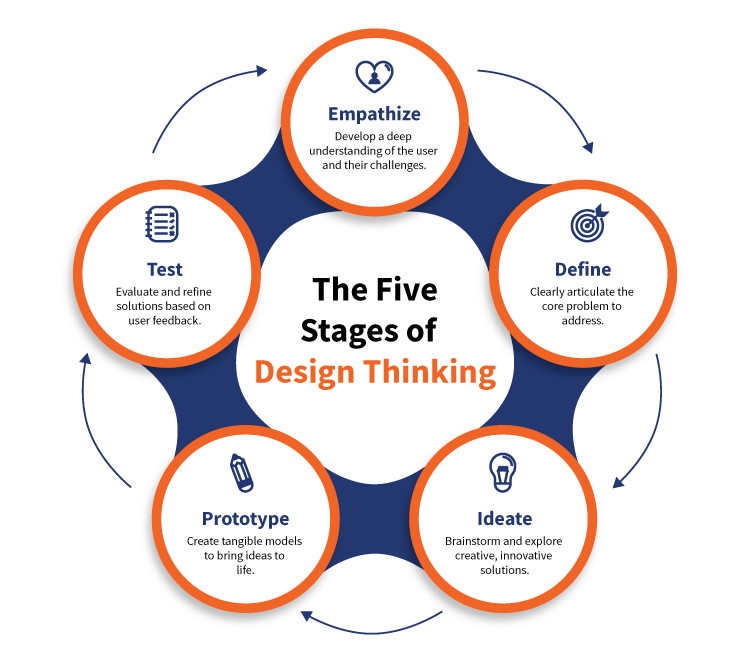What is Design Thinking?
Design Thinking is an innovative problem-solving methodology that emphasises understanding user needs through empathy, fostering creativity, and applying logical analysis to craft effective solutions. Defined by its structured stages—Empathise, Define, Ideate, Prototype, and Test—Design Thinking empower managers to step into the user’s shoes and find innovative solutions that balance user desirability, technological feasibility, and business viability.
Why Design Thinking is Essential in Today’s Business Environment
Design Thinking has become a sought-after methodology because it transcends traditional problem-solving. It enables leaders to approach complex problems with a user-first mindset, which is essential in fields ranging from healthcare to technology, customer service, and beyond.
Core Principles of Design Thinking
- Empathy: Understanding the user’s context, emotions, and experiences, empathy enables managers to connect with customers on a deeper level, leading to solutions that genuinely address users’ needs.
- Collaboration: Bringing together diverse teams fosters creativity. Design Thinking thrives on interdisciplinary collaboration, allowing managers to gain new perspectives and generate innovative solutions.
- Experimentation: Design Thinking values trial and error, allowing ideas to evolve through prototyping and testing. This iterative process ensures that solutions are optimised before being deployed.
Design Thinking Mindsets: More than a Process
A mindset is a mental attitude that guides how individuals interpret and respond to situations. In Design Thinking, specific mindsets shape how people feel, think, and act during the design process, influencing their expectations, openness to ideas, and interactions with team members. Without the right mindsets, Design Thinking can become rigid and ineffective.
Below are the essential mindsets that help ensure a team can implement Design Thinking successfully:
1. Be Empathetic
- Empathy forms the cornerstone of Design Thinking, enabling individuals to deeply understand users’ perspectives, uncover their needs, and recognize their underlying motivations. This mindset is essential for managers to see beyond statistics and data, focusing instead on real people—their pain points, desires, and contexts.
- Example: In a project for improving customer service, being empathetic means deeply understanding customer frustrations and emotions rather than just looking at response times or efficiency.
2. Be Collaborative
- Design Thinking thrives on teamwork and diverse perspectives. Collaboration encourages openness, where team members contribute unique viewpoints, ultimately leading to richer ideas. Working collaboratively ensures that no one person is solely responsible for the outcome, allowing creativity to flow freely.
- Example: When creating a marketing strategy, collaboration can involve brainstorming with colleagues from various departments to bring in fresh ideas from different fields of expertise.
3. Be Optimistic
- Optimism is the belief that any problem can be solved with the right approach. In Design Thinking, optimism fuels the drive to pursue bold ideas despite challenges, encouraging teams to view obstacles as opportunities for innovation.
- Example: Even if a solution faces budget constraints, an optimistic team will explore low-cost alternatives and inventive strategies to make the idea work.
4. Embrace Ambiguity
- Design Thinking requires comfort with uncertainty. Embracing ambiguity enables individuals to navigate complex, unclear situations without the pressure for immediate perfection, which is essential for fostering experimentation and innovation.
- Example: When developing a new product with undefined requirements, embracing ambiguity allows a team to explore various design options, iterate, and learn without being bound by rigid expectations.
5. Be Curious
- Curiosity is essential to uncovering insights that lead to meaningful innovation. Design Thinking encourages an open mind, pushing team members to ask questions, explore new perspectives, and recognize that they are not the user.
- Example: In a healthcare project, curiosity might involve researching patient experiences in detail and challenging any preconceived notions about what patients need.
6. Reframe Assumptions
- Reframing encourages teams to question and rethink assumptions rather than accepting them at face value. Design Thinking promotes breaking through stereotypes and exploring fresh perspectives, ultimately revealing innovative solutions.
- Example: In customer service, reframing an assumption like “Customers want quick solutions” could lead to a deeper insight: “Customers want solutions that feel personal and responsive.”
7. Embrace Diversity
- Diversity in a Design Thinking team is crucial for breaking down biases and assumptions. Working with individuals of different backgrounds brings in new viewpoints, which enhance creativity and foster a more inclusive problem-solving approach.
- Example: Including people from different cultural backgrounds in a design team for a global product helps ensure the solution appeals to a wider, multicultural audience.
8. Make Ideas Tangible
- Tangibility accelerates understanding. Rather than relying on abstract explanations, making ideas tangible through prototypes, sketches, or scenarios allows everyone to see the concept clearly, making collaboration more effective.
- Example: In developing an app, creating quick sketches of the user interface provides a concrete reference point, allowing teams to discuss functionality and design more effectively.
Goals of Design Thinking
1. Desirability: The Human Factor
Desirability centres on recognizing and fulfilling the needs, emotions, and aspirations of the end user. In Design Thinking, it is cultivated through empathetic understanding and research that places the user at the heart of the process. Solutions must be meaningful and relevant to the people they are designed for—whether they are customers, employees, or other stakeholders.
Why Desirability is Crucial:
- It ensures that the solution solves a real problem or fulfils a genuine need.
- It creates an emotional connection with users, fostering loyalty and satisfaction.
- It helps avoid creating products or services that are functionally excellent but fail to resonate with users.
2. Feasibility: The Technical Factor
Feasibility ensures that the solution can be developed and implemented using existing technologies, resources, and capabilities. This factor addresses the question: Can we actually build this solution, and will it work as intended?
Why Feasibility is Crucial:
- It grounds creativity in practicality, ensuring that ideas can be translated into reality.
- It identifies technical challenges early, reducing the risk of costly failures during execution.
- It aligns the solution with the organisation’s technical expertise and infrastructure.
3. Viability: The Business Factor
Viability assesses whether the solution makes sense from a financial and strategic perspective. It addresses questions like: Will this solution generate revenue? Is it sustainable over time? Does it align with the organisation’s goals?
Why Viability is Crucial:
- It ensures the solution is profitable or creates measurable value for the organisation.
- It aligns the innovation with long-term business objectives and market demands.
- It prevents investment in solutions that may appeal to users but are not financially sustainable.
Balancing Desirability, Feasibility, and Viability
The true power of Design Thinking lies in its ability to strike a balance between these three factors. When a solution is:
- Desirable but not feasible or viable: It may resonate with users but cannot be implemented or sustained, leading to wasted resources.
- Feasible but not desirable or viable: It might work technically but fails to address user needs or generate value for the business.
- Viable but not desirable or feasible: It may seem financially sound but lacks user appeal or cannot be realistically built.
The Five Stages of Design Thinking
Design Thinking is typically structured into five stages: Empathise, Define, Ideate, Prototype, and Test. Let’s break down each stage to see how they collectively foster a powerful approach to problem-solving.
1. Empathise: Understand the User
Empathy is the cornerstone of Design Thinking, where managers seek to deeply understand the user’s problems, emotions, and perspectives. In management, this translates into identifying customer pain points and market gaps, which form the foundation for innovative solutions. Tools like user interviews, empathy mapping, and observation are commonly used.
Skills Developed: Active listening, emotional intelligence, and analytical observation.
2. Define: Articulate the Problem
In the Define stage, the insights gathered are synthesised to pinpoint the core problem. For managers, defining the right problem is critical, as it shapes the solutions they develop. The Define stage helps managers avoid vague or misdirected efforts by ensuring they are addressing a specific, well-articulated challenge.
Skills Developed: Critical thinking, problem framing, and strategic vision.
3. Ideate: Generate Solutions
During Ideation, creativity is at the forefront as managers brainstorm potential solutions. Techniques such as brainstorming, mind mapping, and “worst possible idea” exercises help unlock unconventional ideas. Managers use this phase to think beyond constraints, exploring multiple approaches before narrowing down feasible options.
Skills Developed: Creative thinking, lateral thinking, and collaboration.
4. Prototype: Build Tangible Representations
Prototyping involves creating simple models or simulations of the ideas generated. In management, this can mean building a minimum viable product (MVP) or a service model that allows feedback before the final launch. This stage emphasises hands-on experimentation, where managers learn by doing and receive valuable feedback.
Skills Developed: Practical application, resourcefulness, and project management.
5. Test: Refine and Optimise
Testing is the phase where prototypes are evaluated, refined, and improved based on real-world feedback. In management, testing ensures that the solution is both viable and effective, providing insights into areas for improvement. Testing can involve focus groups, A/B testing, or pilot programs, depending on the nature of the solution.
Skills Developed: Adaptability, data analysis, and resilience.
Why Design Thinking is Essential for Aspiring Managers
For management students, mastering Design Thinking offers a competitive edge in the job market and prepares them for complex, high-stakes roles. Here are a few reasons why Design Thinking is critical:
1. Driving Innovation Across Industries
Companies like Google, Apple, and Procter & Gamble utilise Design Thinking to remain leaders in innovation. For managers, the ability to think creatively and empathetically is a powerful asset for addressing customer needs, enhancing user experience, and developing innovative business models.
2. Building Resilient and Adaptive Leaders
Design Thinking fosters a mindset of continuous improvement, adaptability, and resilience. These traits are essential for leaders who must navigate changing markets, disruptive technology, and global challenges.
3. Enhancing Career Prospects
A Design Thinking background is highly valued in today’s business landscape. Skills like empathy, innovation, and strategic problem-solving are in high demand, and professionals with these abilities often excel in roles requiring leadership, customer focus, and agility.
How Badruka’s PGDM Program Integrates Design Thinking
At Badruka School of Management, Design Thinking is more than a module; it’s an integral part of the PGDM curriculum. Through immersive, hands-on projects and real-world applications, students learn to apply Design Thinking to complex business problems. Highlights of Badruka’s approach include:
- Industry Immersion: Badruka emphasises industry experience, allowing students to apply Design Thinking principles in real business environments.
- Collaborative Projects: Students engage in team projects, enhancing their collaboration and innovation skills.
- Focus on Practical Skills: The program prioritises workplace readiness, ensuring that graduates are equipped to meet the demands of dynamic business environments.
Graduates from Badruka’s PGDM program emerge as well-rounded, adaptive leaders prepared to innovate, lead, and create impact.
How Design Thinking in Badruka’s PGDM Program Can Boost Your Career
Completing a PGDM with a focus on Design Thinking offers a solid foundation for career growth. By learning a skill set that combines empathy, creativity, and problem-solving, you’ll be positioned to take on leadership roles in sectors like technology, finance, healthcare, and consulting. Badruka’s approach ensures that students are not only prepared to face today’s challenges but are also equipped to drive tomorrow’s innovations.
Ready to Transform Your Career with Design Thinking?
Explore how Badruka’s PGDM program in Design Thinking can help you develop the skills to innovate and lead. With a comprehensive curriculum focused on real-world applications, Badruka prepares you for a successful, impactful career.
Learn more about the program and take the next step today!





